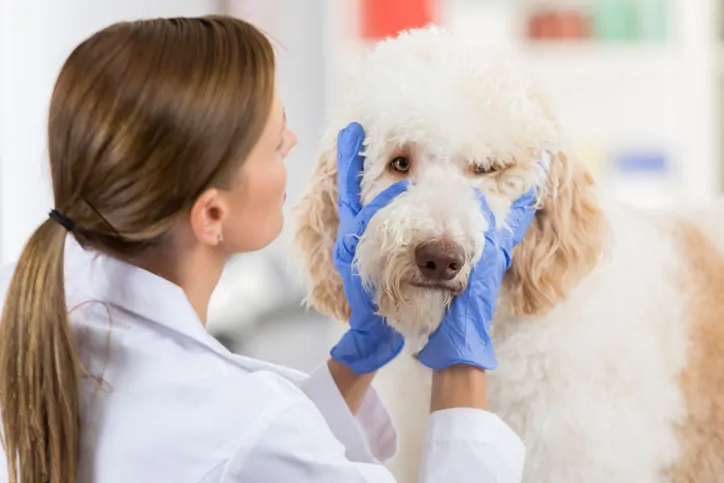Trauma-related corneal damage is the most common eye condition in dogs, followed by dry eye disease and conjunctivitis (pink eye).
Symptoms of common dog eye conditions include red or pink eyes, cloudy eyes, discharge, squinting, swelling, itchiness, and pain or distress.
Trauma is the most common cause of dog eye conditions, often in combination with a secondary infection.
Treatment for common eye conditions in dogs ranges from medicated eye drops and oral medications to surgical interventions.
Preventing eye conditions in your dog consists of avoiding situations where your dog's eyes may be injured along with maintaining regular wellness visits to detect any eye changes early.
Common dog eye conditions can range from little irritants, like allergies and minor scratches, to more severe conditions, like glaucoma and significant wounds. Whatever the underlying reason for your dog's eye condition, the most important thing is to act and seek veterinarian care as soon as possible because even minor eye issues can get worse.

The most common dog eye conditions are corneal damage, caused by trauma, followed by dry eye and pink eye. Other common eye issues in dogs include eyelid masses, cataracts, glaucoma, and cherry eye. Here are some of the symptoms your dog may have if they are suffering from one of these conditions:
Symptoms of common eye conditions in dogs may appear in one or both eyes. If you notice tearing, tear-stained fur, discharge, closed or squinted eyes, a visible third eyelid, or pupils of unequal size, your dog may be experiencing a serious eye condition and you should call your vet immediately to schedule a consultation.
There are several causes of eye conditions in dogs. The most prevalent dog eye issues are associated with trauma and certain eye conditions occur more in some breeds than others. Here are several eye conditions that commonly affect dogs:
Eye conditions in dogs need a proper diagnosis for effective treatment. Once your dog exhibits symptoms, take them to the vet because symptoms can escalate in a short period of time. Your vet can perform a series of tests to identify the issue and establish a treatment plan.
One of the first tests your vet may perform is the Schirmer tear test. This examination gauges your dog's ability to produce tears by placing small paper strips are placed beneath your dog's eyelids for one minute.
Your vet may also order a fluorescein stain which checks the surface of your dog's eye for blemishes, ulcers, and other abnormalities. It can also be used to assess the drainage and quality of tears. This test consists of the application of a green stain to each eye, followed by an examination of the eyes under a special blue light.
The most important test is the measurement of eye pressure. Certain eye conditions can induce changes in ocular pressure that can be painful and cause serious complications. A sensitive pressure-measuring instrument is used to tap the eye's surface throughout the procedure. Don't worry, numbing eye drops will be applied, so your dog will be comfortable during this process.
Blood tests and cultures may also be ordered to check for bacterial growth or other underlying conditions, depending on your dog's symptoms.
Your dog's physical examination and diagnostic test results will be used to guide the course of treatment. Here are a few typical remedies:
It's also good to know that many of the drugs offered as doggie eye "drops" are available as ointments. Your veterinarian can advise you on which option is best for your pup.
Unfortunately, not all eye issues can be avoided. However, there are certain things you can do to reduce the risk for your dog:
Avoid situations that could cause eye injuries, such as letting your dog run through bushes with pointed branches.
Have eye conditions treated by your dog's vet as soon as possible. If left untreated, eye issues can quickly worsen. Early intervention may prevent complications and keep your dog more comfortable.
Attend routine checkups as advised. Wellness checkups assist in spotting early warning signs of eye conditions in your dog and allow for quicker treatment and better outcomes.
While disorders such as glaucoma or deep ulcers may call for more intensive care, the majority of eye issues are easy to manage and have fast recovery times. So, it is likely that your dog will return to normal if you seek veterinary care for your furry family member as soon as their eye condition becomes noticeable.
Phone: (855) 461-8259
Email: [email protected]